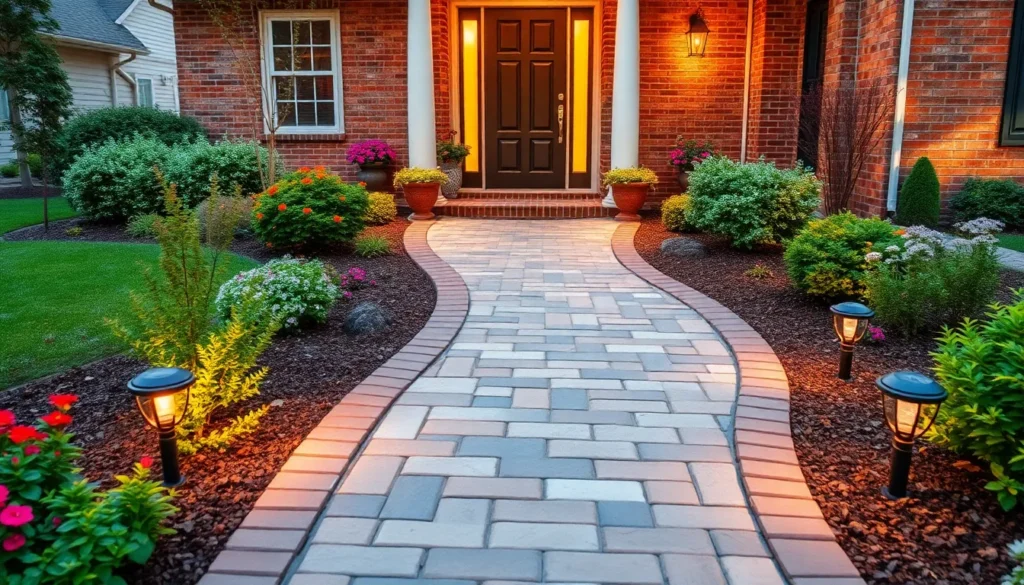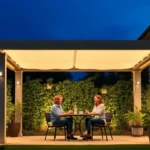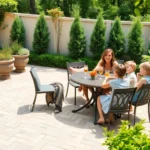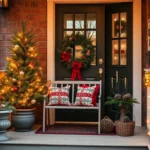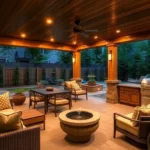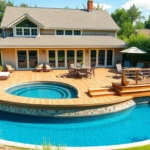Your front door walkway serves as the opening act to your home’s story – it’s the first impression guests receive and sets the tone for what lies beyond. We’ve all experienced that moment of walking up to a beautifully designed entrance that makes us pause and admire the thoughtful details.
Whether you’re working with a straight concrete path that needs personality or starting from scratch with a blank slate, the right walkway design transforms your entrance from ordinary to extraordinary. From natural stone pavers that whisper elegance to modern geometric patterns that make bold statements, the possibilities are endless.
We’ll explore creative answers that work within any budget and complement various home styles. You don’t need a complete renovation to achieve stunning results – sometimes the most impactful changes come from strategic material choices, clever lighting, or thoughtful landscaping touches that frame your path perfectly.
Create a Grand Entrance With Stone Walkway Designs
Stone walkways deliver timeless elegance that transforms any front entrance into a stunning focal point. We’ve found that stone materials offer durability and natural beauty that complement virtually every architectural style.
Natural Flagstone Pathways
Flagstone creates organic appeal through its irregular shapes and earth tone variations. We recommend selecting stones that range from 18 to 24 inches in diameter for optimal visual impact and walking comfort. Pennsylvania bluestone offers cool gray hues that pair beautifully with colonial and craftsman homes. Arizona flagstone provides warm rust and gold tones that enhance southwestern and contemporary designs.
Installation involves setting stones directly into sand or mortar for different aesthetic effects. Sand joints allow grass or moss to grow between stones for a more natural appearance. Mortar joints create clean lines and prevent weed growth while maintaining a polished look. We suggest spacing stones with 1 to 2 inch gaps to achieve the perfect balance between stability and visual interest.
Brick Paver Combinations
Brick pavers blend traditional charm with modern installation techniques for lasting beauty. We often combine red clay bricks with natural stone accents to create stunning pattern variations. Herringbone patterns add visual texture while running bond layouts provide classic simplicity.
Mixed material approaches work exceptionally well for front door walkways. Combining brick borders with flagstone centers creates defined edges while maintaining organic appeal. We’ve seen great results using reclaimed bricks paired with limestone accents for vintage character. These combinations typically cost 20 to 30 percent less than solid stone installations while delivering comparable visual impact.
Permeable brick options allow water drainage while maintaining structural integrity. These specialized pavers feature wider joints filled with gravel or sand that prevent runoff issues common in traditional installations.
Concrete Slab Layouts
Concrete slabs offer versatility through stamped patterns, color treatments, and textural finishes. We recommend using concrete slabs that measure 24 by 24 inches or larger to create bold geometric statements. Stamped concrete can mimic natural stone textures at 40 to 50 percent lower costs than genuine materials.
Decorative concrete options include exposed aggregate finishes that reveal beautiful stone particles within the surface. Acid staining produces rich color variations that replicate natural stone patina. We often suggest combining smooth concrete borders with textured center sections for added visual interest.
Large format concrete pavers create modern minimalist appeal perfect for contemporary home designs. These oversized elements reduce joint lines while maximizing clean geometric impact along front door walkways.
Design Curved Walkways for Visual Appeal
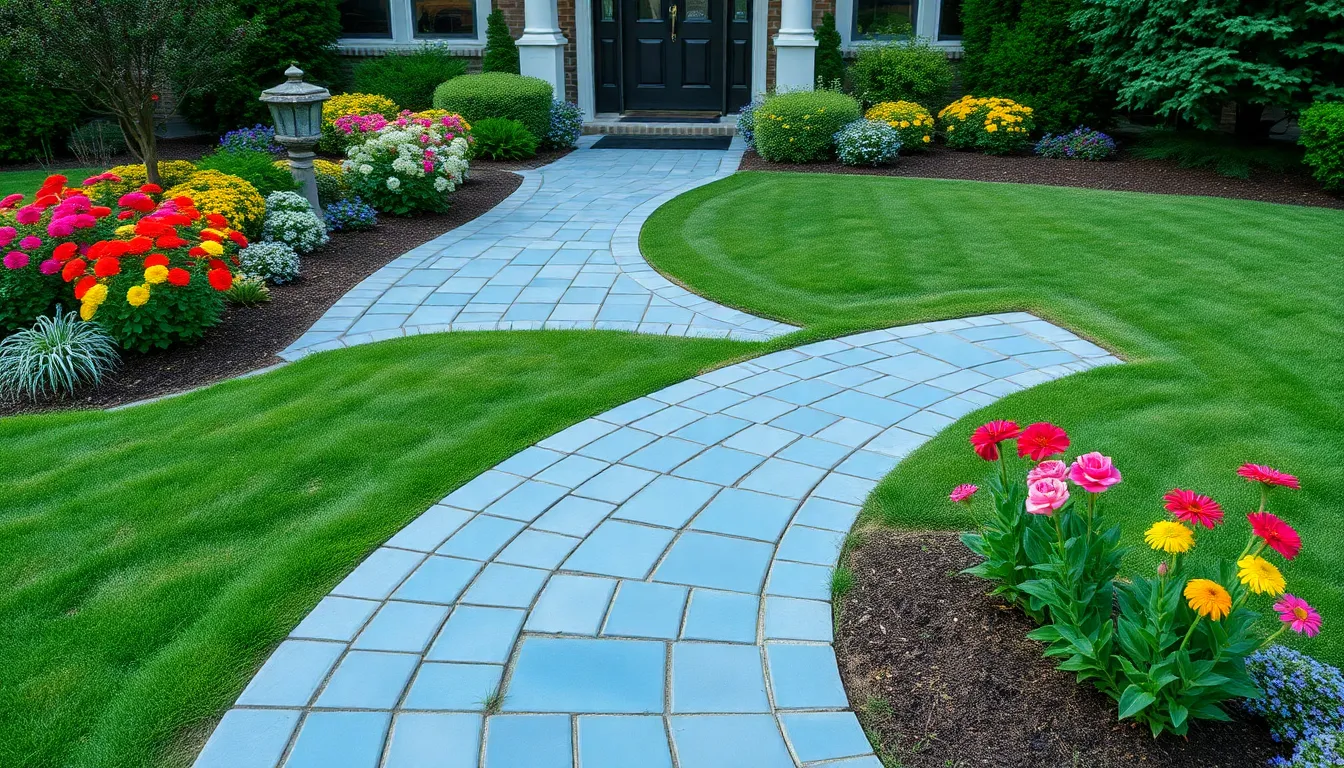
Curved pathways break away from rigid straight lines and create an inviting flow that naturally draws visitors to your front door. We’ll explore three distinct approaches that transform ordinary entrances into welcoming journeys.
Serpentine Garden Paths
Serpentine paths meander gracefully through landscaped areas, creating an informal and relaxed atmosphere that encourages exploration. These winding routes work exceptionally well when you want to showcase garden features like flower beds, ornamental shrubs, or decorative plantings along the way.
Thermal blue flagstone arranged in serpentine patterns transforms a simple walkway into an elegant journey that connects visitors intimately with your front yard environment. The gentle curves allow you to incorporate multiple viewing angles of your landscaping while maintaining a clear direction toward the entrance.
Installation becomes more flexible with serpentine designs since the curved nature accommodates natural grade changes and existing industry features. We recommend spacing flagstones with 2-3 inch gaps filled with decorative gravel or ground cover plants to enhance the organic feel.
Gentle Arc Configurations
Gentle arcs provide subtle guidance while framing garden beds or water features alongside your walkway route. This approach offers more structure than serpentine paths but maintains the softness that curved designs bring to front yard aesthetics.
Brick pavers in basket weave patterns work exceptionally well for gentle arc configurations, combining traditional materials with graceful curves that add both texture and visual interest. The regular pattern of the weave creates stability while the curved edges soften the overall appearance.
Strategic placement of these arcs allows you to highlight exact industry elements like specimen trees, decorative boulders, or seasonal flower displays. We suggest creating viewing pockets where the curve naturally pauses, giving visitors moments to appreciate your garden design.
Sweeping Entrance Approaches
Sweeping approaches feature broad, curved walkways that create grand first impressions while maintaining an inviting atmosphere for guests. These designs work particularly well for homes with longer front yard depths where you have space to develop the full curve.
Walkways bordered by plants and enhanced with water features serve dual purposes as both functional pathways and relaxation spaces for greeting guests. The generous width accommodates side conversations while the sweeping nature creates anticipation as visitors approach your door.
Lighting integration becomes crucial for sweeping approaches since the extended pathway benefits from multiple illumination points along the curve. We recommend placing low voltage fixtures every 8-10 feet on alternating sides to create rhythm while ensuring safety throughout the journey.
Incorporate Lighting Elements Into Your Walkway
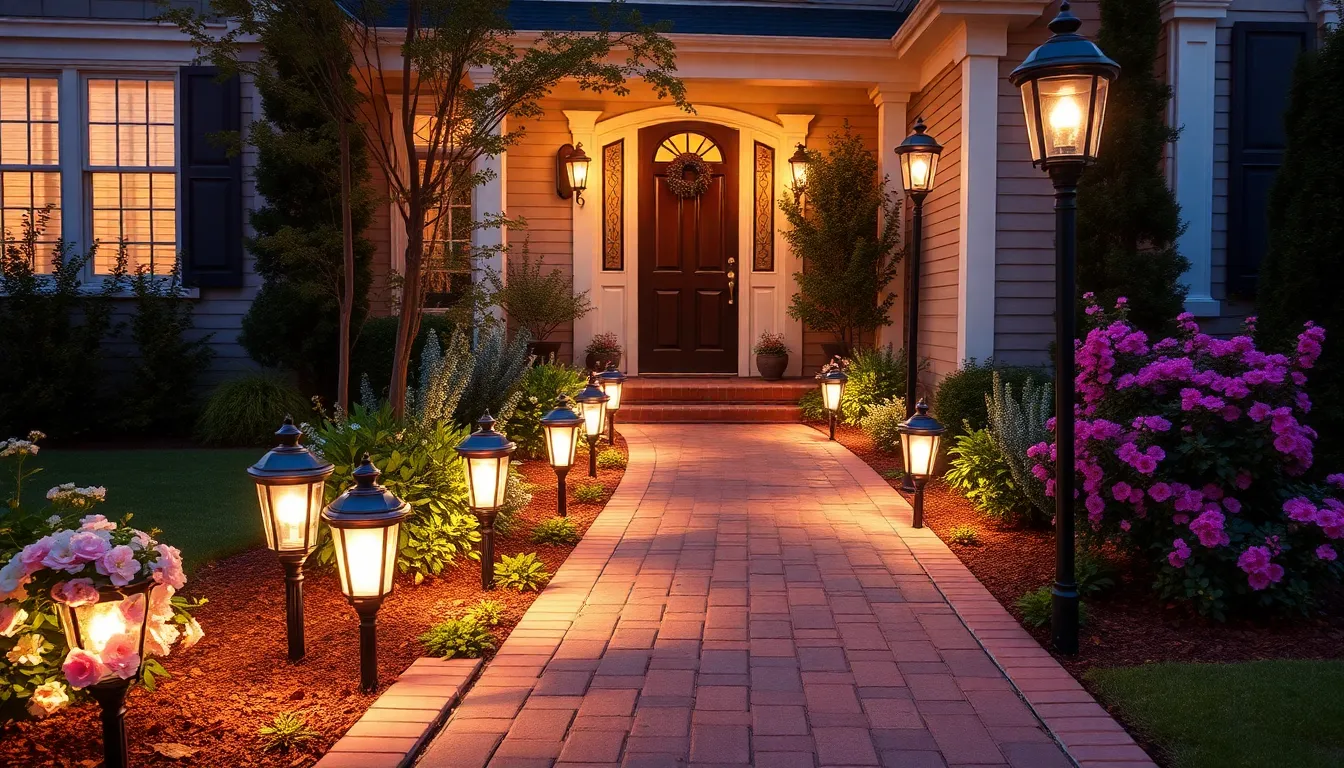
Strategic lighting transforms front door walkways from merely functional paths into stunning architectural statements. We’ll explore three essential lighting approaches that enhance both safety and curb appeal.
Solar-Powered Path Lights
Solar powered path lights deliver eco-friendly illumination without the complexity of electrical installations. These fixtures charge automatically during daylight hours and activate at dusk to provide soft guidance along walkway edges. We recommend positioning them every 6 to 8 feet along your pathway to create consistent lighting patterns.
Installation requires no wiring since these units operate independently through built-in photovoltaic panels. They’re particularly effective when paired with curved walkway designs like serpentine garden paths, where the gentle glow highlights the natural flow of the pathway. Cost effectiveness makes solar lights an excellent choice for homeowners seeking sustainable lighting answers that complement materials like flagstone or brick pavers.
LED Strip Installations
LED strip lights create continuous illumination that defines walkway boundaries with modern precision. These versatile fixtures install seamlessly under raised pavers or along pathway edges to establish clean visual lines. We suggest using warm white LED strips to maintain a welcoming atmosphere while providing adequate visibility.
Energy efficiency sets LED strips apart from traditional lighting options, consuming significantly less power while delivering consistent brightness levels. They’re available in various colors and brightness settings, allowing customization to match your home’s architectural style. Pairing LED strips with concrete slab layouts creates striking geometric effects that emphasize the walkway’s contemporary design elements.
Lantern-Style Fixtures
Lantern style fixtures bring classic elegance to front walkways through warm ambient lighting that welcomes visitors. These timeless fixtures mount on posts along the pathway or suspend near entryways to create inviting focal points. We recommend pairing lanterns with traditional materials like brick or flagstone to enhance the cohesive aesthetic appeal.
Post mounted lanterns work exceptionally well with sweeping entrance approaches, where their elevated position maximizes light distribution across wider pathways. The warm glow from lantern fixtures complements natural landscaping elements like flowering plants and ornamental grasses, creating layered lighting effects that enhance the walkway’s overall charm and functionality.
Add Landscaping Features Along Your Path
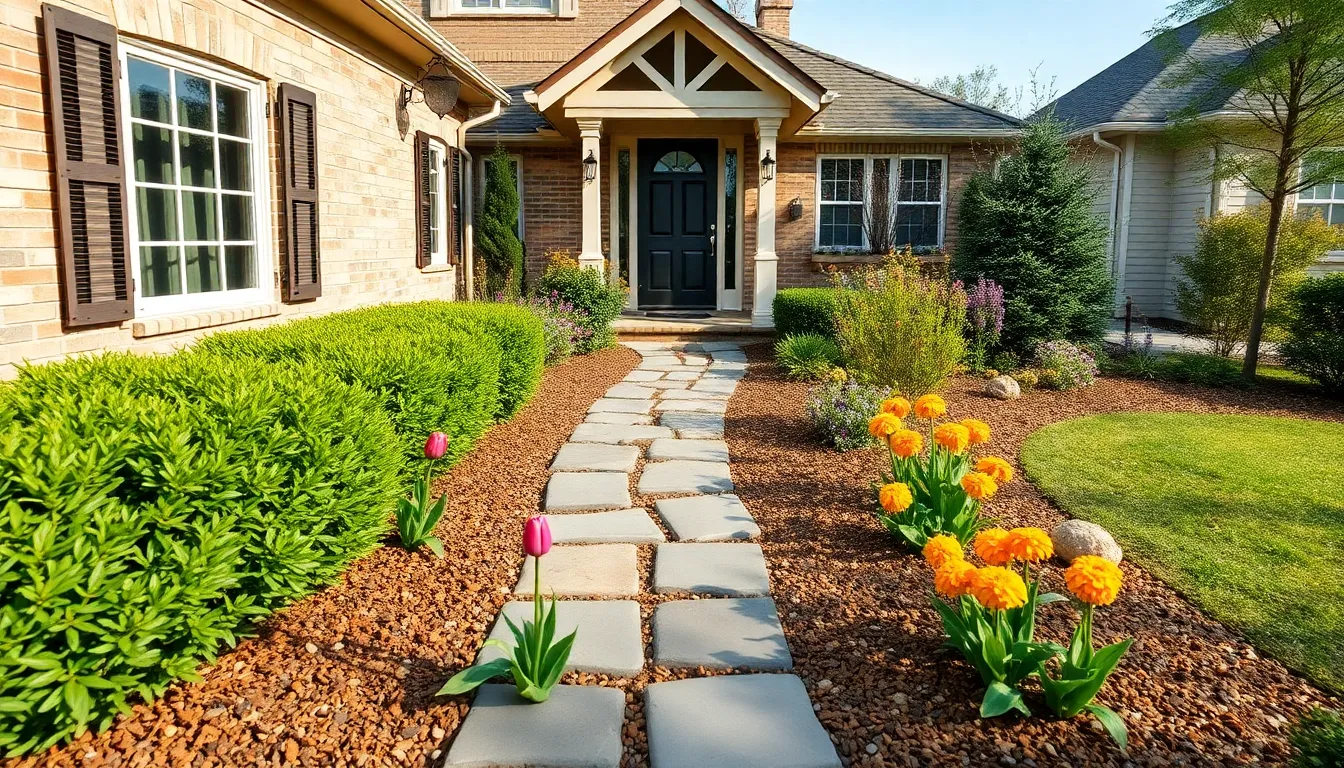
Landscaping transforms your walkway from a simple path into an inviting entrance that welcomes guests and enhances your home’s curb appeal. Strategic plant placement and decorative elements create visual interest while complementing your existing hardscape materials.
Border Plant Selections
Low-growing shrubs create the foundation for well-defined walkway borders. We recommend boxwoods and dwarf hollies for neat hedges that maintain their shape throughout the year. These evergreen options provide consistent structure while serving as a backdrop for seasonal color additions.
Perennials offer ongoing blooms and changing textures across multiple seasons. Consider lavender for its fragrant purple spikes and silvery foliage, or hostas for their broad leaves and elegant white or purple flower spikes. Daylilies bring vibrant colors like yellow, orange, and red while requiring minimal maintenance once established.
Ornamental grasses add movement and softness to rigid walkway lines. Popular varieties include fountain grass, feather reed grass, and blue fescue, which create gentle swaying motion and interesting seed heads. These grasses complement both traditional and modern architectural styles.
Evergreen selections ensure year-round visual interest when deciduous plants lose their leaves. Small conifers like dwarf Alberta spruce or compact junipers provide vertical elements and rich green color during winter months.
Decorative Mulch Options
Natural wood chips deliver warm earthy tones that complement stone and brick walkways. Cedar and hardwood bark mulches break down slowly while suppressing weeds and retaining soil moisture around border plants. These organic options improve soil health as they decompose over time.
Colored mulch creates striking contrast with both plants and hardscape materials. Red mulch enhances brick walkways and complements green foliage, while black mulch provides dramatic backdrop for colorful flowers. Cocoa brown mulch offers a rich, neutral tone that works with various color schemes.
Stone mulch provides a modern, low-maintenance alternative to organic materials. Pea gravel comes in colors like gray, tan, and white to match different architectural styles. River rock and lava rock offer larger textures and unique colors for contemporary industry designs.
Rubber mulch made from recycled tires lasts longer than organic options while providing excellent weed suppression. This eco-friendly choice comes in multiple colors and won’t fade or blow away during storms.
Seasonal Flower Arrangements
Spring flowers bring early color after winter’s dormancy period. Plant tulips and daffodils in fall for spectacular spring displays, while pansies provide immediate color in cooler spring weather. Crocuses emerge through snow for the earliest seasonal interest.
Summer arrangements thrive in warmer temperatures and longer daylight hours. Petunias cascade beautifully from containers or spread across border beds, while marigolds offer bright orange and yellow blooms that repel certain pests. Impatiens flourish in partial shade areas, and geraniums provide classic appeal in containers or ground plantings.
Fall displays celebrate autumn’s rich color palette through chrysanthemums in bronze, burgundy, and gold tones. Ornamental kale adds unique textures with its ruffled leaves in purple, white, and green combinations. Asters produce small daisy-like flowers in purple, pink, and white that attract beneficial pollinators.
Winter interest comes from evergreen boughs, holly berries, and winter-blooming pansies in protected microclimates. These elements maintain visual appeal when most perennials have gone dormant, ensuring your walkway remains attractive throughout the coldest months.
Choose Materials That Match Your Home’s Style
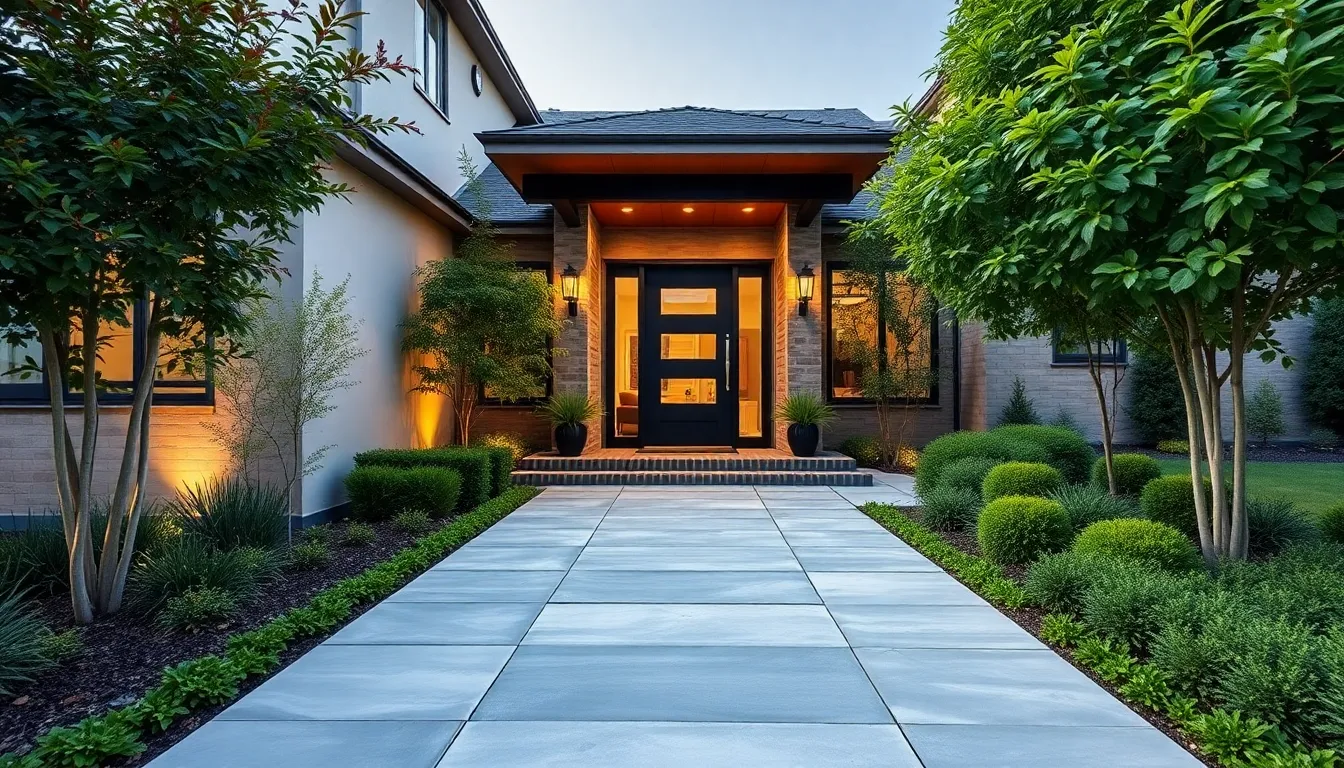
Selecting walkway materials that complement your home’s architectural style creates visual harmony and enhances curb appeal. We’ll explore three popular material categories that align with different design aesthetics to help you make the perfect choice.
Modern Concrete Designs
Concrete pavers deliver the clean, sophisticated look that contemporary homes demand. We recommend large format pavers that mimic natural stone textures like flagstone while offering superior durability at a lower cost. These modern materials allow us to create sleek, uniform patterns that emphasize geometric precision.
Customization options make concrete particularly appealing for modern walkway ideas. Colors and shapes can be customized to match your home’s exterior palette, while stamped patterns add visual interest without compromising the minimalist aesthetic. Modern concrete pavers tend to feature larger dimensions that create bold statements and reduce visual clutter.
The durability factor sets concrete apart from other materials. These pavers withstand heavy foot traffic and weather extremes while maintaining their appearance for decades. Installation flexibility allows us to incorporate contemporary design elements like LED strip lighting channels or geometric inlay patterns.
Traditional Brick Patterns
Brick pavers bring timeless charm and classic elegance to front door walkways. We particularly recommend traditional patterns like basket weave and soldier courses that add sophisticated texture and visual depth. These patterns work exceptionally well with historic, colonial, and traditional home styles.
Warmth and character define brick’s appeal for traditional walkway designs. The natural color variations and weathered appearance create an inviting atmosphere that welcomes guests. Brick complements many architectural styles while offering proven durability that improves with age.
Pattern versatility gives us many design options with brick materials. Running bond layouts create clean lines, while herringbone patterns add ever-changing visual movement. We often combine different laying patterns to create transition zones or highlight exact walkway sections.
Maintenance requirements for brick remain minimal compared to natural stone options. Regular sweeping and occasional power washing keep brick walkways looking pristine. The porous nature of brick allows for excellent drainage while preventing slip hazards during wet conditions.
Rustic Gravel Combinations
Gravel walkways offer affordable, natural looking answers perfect for cottage, country, and rustic home styles. We recommend crushed stone options like limestone or granite that provide stable footing while maintaining an organic, casual appearance. These materials emphasize the relaxed, unpretentious vibe that rustic designs celebrate.
Edging materials become crucial for successful gravel installations. Metal, stone, or wood borders contain the gravel while creating defined walkway boundaries. We prefer natural stone edging for its seamless integration with the surrounding industry.
Cost effectiveness makes gravel an attractive option for budget conscious homeowners. Installation requires minimal site preparation compared to paver systems, and materials cost significantly less than brick or concrete alternatives. Maintenance involves periodic raking and occasional material replenishment.
Drainage benefits make gravel walkways ideal for areas with heavy rainfall or poor soil conditions. Water flows freely through the material, preventing puddles and ice formation. We often combine gravel with stepping stones or larger accent rocks to create interesting visual focal points while maintaining functionality.
Install Practical Safety Features
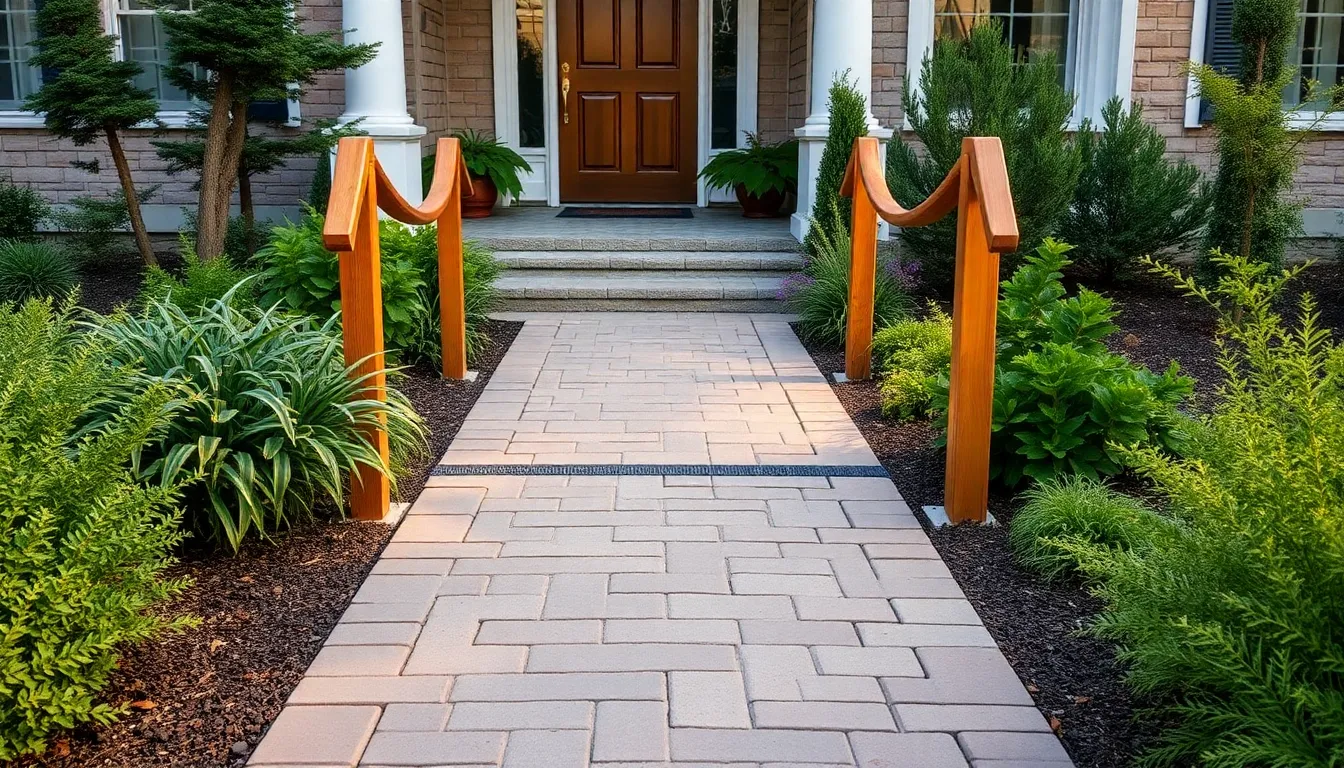
Safety should never be an afterthought when designing your front door walkway. We’ll explore three essential safety upgrades that protect family members and guests while maintaining the aesthetic appeal of your entrance.
Non-Slip Surface Treatments
Textured materials provide the foundation for slip-resistant walkways that perform well in all weather conditions. We recommend choosing pavers with inherent non-slip properties, such as Series™ or Umbriano® pavers, which offer superior traction without compromising visual appeal. Permeable pavers with spacer bars create an excellent drainage system that prevents water accumulation and reduces slippery conditions.
Concrete surfaces benefit from stamped textures or specialized treatments that increase grip while maintaining an attractive appearance. Regular maintenance plays a crucial role in safety performance, including re-leveling uneven pavers and clearing debris that can create hazardous walking conditions. These surface treatments significantly reduce slip risks, especially during wet or icy weather when walkways become most dangerous.
Handrail Installations
Sturdy handrails provide essential support for individuals with mobility challenges and anyone handling steep inclines. We suggest installing wooden rails as a popular and safe choice that combines durability with natural beauty. Handrails must be securely mounted and capable of supporting important weight without any wobbling or movement.
Walkway width becomes critical when incorporating handrails, with a minimum of 42 inches (3.5 feet) required for wheelchair accessibility and comfortable handrail use. Proper installation ensures that handrails offer reliable stability while complementing your walkway’s overall design aesthetic. Strategic placement of handrails can also enhance the visual flow of curved or multi-level walkways.
Proper Drainage Answers
Effective water management prevents both safety hazards and structural damage to your walkway investment. We recommend installing permeable pavers that allow rainwater to naturally seep into the ground, eliminating standing water that creates slippery surfaces. Strategic grading and slight slopes direct water away from the walking path, ensuring dry and safe conditions year-round.
| Drainage Solution | Benefit | Implementation |
|---|---|---|
| Permeable Pavers | Prevents water pooling | Natural ground absorption |
| Walkway Grading | Directs water flow | Slight slope away from path |
| Covered Sections | Weather protection | Reduces maintenance needs |
Covered walkway sections provide additional protection from rain and snow, reducing both maintenance requirements and weather-related hazards. Integrated lighting along drainage channels improves nighttime visibility while highlighting safety features. These drainage answers work together to create walkways that remain safe and functional regardless of weather conditions.
Create Width Variations for Different Needs
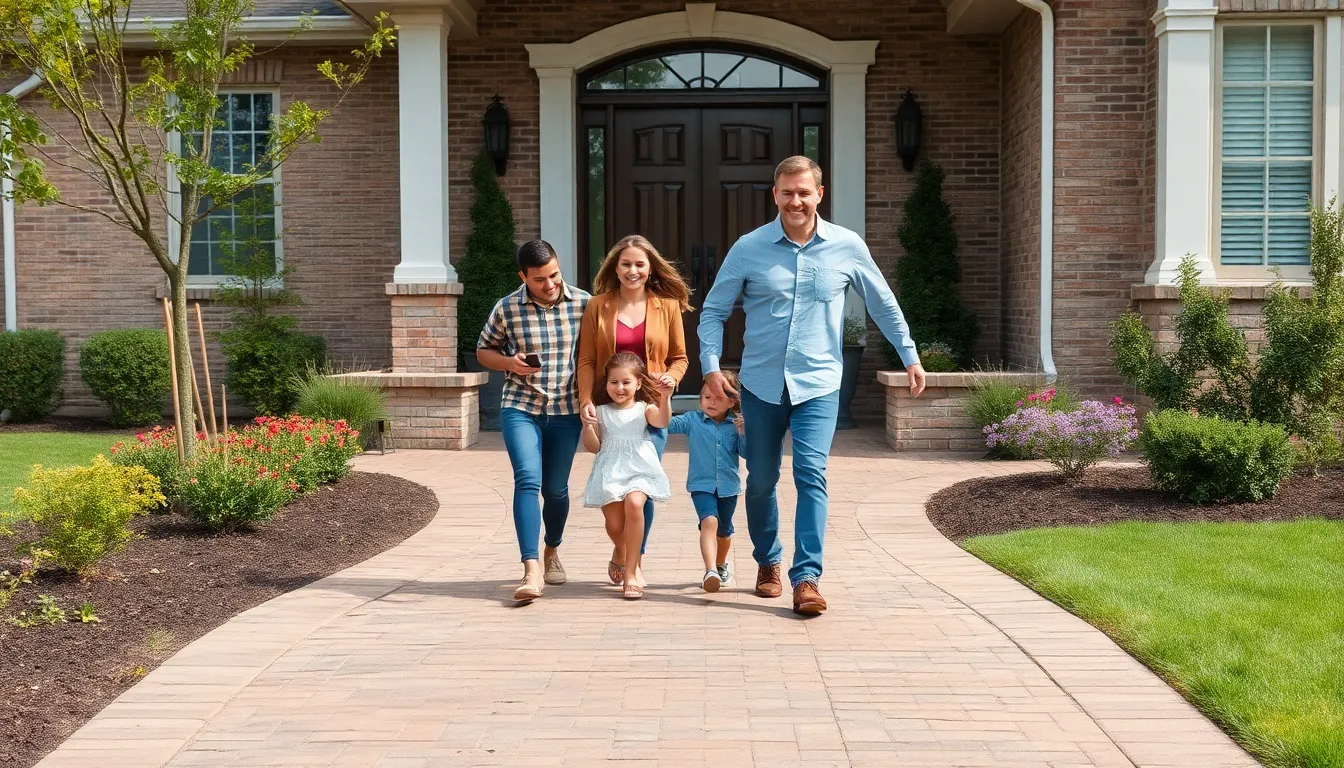
When designing walkways, we must consider how different users will navigate the space. Thoughtful width planning ensures everyone can access your front door comfortably and safely.
Single-Person Walkway Dimensions
Standard single-person walkways measure approximately 3 feet wide, providing adequate space for comfortable individual navigation. This dimension allows one person to walk safely while maintaining proper balance and avoiding obstacles. Narrower paths may feel cramped and unwelcoming, while slightly wider options enhance visual impact without overwhelming smaller properties.
Budget-conscious homeowners often choose this width for its material efficiency and space-saving benefits. The 3-foot standard works exceptionally well for direct paths from driveways or streets to front doors. Most building codes accept this width for residential walkways, making permit approval straightforward.
Double-Wide Path Options
Spacious walkways measuring 5 to 6 feet wide accommodate multiple people walking side by side comfortably. These generous dimensions create a welcoming entrance that feels grand and inviting to guests. Families with children particularly benefit from this extra space, allowing parents and kids to walk together safely.
Package delivery becomes much easier with double-wide paths, as delivery personnel have room to maneuver large items. Two people can pass each other without stepping off the walkway, improving traffic flow during gatherings. The wider surface also provides better visual balance for larger homes and creates more opportunities for decorative elements.
Wheelchair Accessible Designs
Accessible walkways require a minimum 36-inch clear width, though we recommend 48 inches or more for optimal comfort. This generous spacing allows wheelchair users to navigate confidently without feeling constrained by narrow passages. The surface must remain smooth and slip-resistant, with materials like brick pavers on stable bases or flagstone over concrete providing excellent options.
| Accessibility Feature | Requirement | Recommendation |
|---|---|---|
| Minimum Width | 36 inches | 48+ inches |
| Maximum Slope | 1:12 ratio | Gentler when possible |
| Surface Type | Non-slip | Textured pavers |
| Turn Radius | Wide curves | Avoid sharp angles |
Slopes should never exceed the 1:12 ratio, ensuring wheelchairs can navigate inclines safely. Gentle curves work better than sharp turns, allowing smooth wheelchair maneuverability throughout the path. Installing tactile warning strips at elevation changes helps visually impaired users navigate confidently.
Integrate Steps and Level Changes

Incorporating steps and level changes transforms challenging terrain into stunning design opportunities. We can create visual interest while managing elevation changes through strategic stair placement and thoughtful material selection.
Terraced Walkway Systems
Terraced walkway systems break steep slopes into manageable, flat sections that create distinct outdoor spaces. We recommend combining these terraces with retaining walls or raised garden beds to add architectural structure while controlling erosion and water runoff.
Breaking inclines into smaller terraces makes navigation easier for visitors while creating natural stopping points along the path. Stone terraces work particularly well with natural flagstone or brick pavers, offering different textures that complement various home facades.
Creating distinct outdoor rooms through terracing allows us to incorporate seating areas or decorative plantings between levels. Each terrace becomes an opportunity to showcase different landscaping elements, from seasonal flowers to ornamental grasses that add movement and visual appeal.
Strategic placement of terraced systems helps manage water drainage effectively while providing stable foundations for walkway materials. We can enhance these designs with integrated lighting between levels, ensuring safe navigation during evening hours.
Gradual Slope Transitions
Gradual slope transitions provide wheelchair-friendly access without requiring traditional steps or dramatic elevation changes. We achieve comfortable movement by using gentle inclines with materials like flagstone set on concrete or interlocking pavers that create smooth surfaces.
Improving mild slopes with contrasting edging materials adds definition and safety while maintaining universal accessibility. These transitions guide visitors naturally toward the front door while accommodating users with different mobility needs.
Balancing aesthetics with functionality, we can incorporate decorative elements like integrated lighting strips along the edges of gradual transitions. This approach creates visual interest while ensuring safe navigation during all weather conditions.
Material selection becomes crucial for gradual transitions, as we need surfaces that provide adequate traction without creating obstacles. Textured concrete pavers or natural stone with slight surface variations offer both beauty and practical slip resistance.
Decorative Stair Elements
Decorative stair elements elevate ordinary steps into architectural focal points that enhance curb appeal. We can use thermal blue flagstone steps, natural stone risers, or brick paver stairs with patterned edges to add texture and striking color contrasts.
Adding integrated features like wrought iron railings or planters beside steps creates both charm and safety for visitors. These elements transform functional stairs into welcoming design statements that reflect the home’s architectural character.
Incorporating lighting directly into stair elements ensures safe navigation while highlighting the decorative aspects of the design. LED strip lighting along risers or solar-powered fixtures beside steps create dramatic evening presentations.
Varying materials within stair construction adds visual depth and prevents monotonous appearances. Combining natural stone risers with brick paver treads or concrete steps with decorative side panels creates ever-changing presentations that draw attention to the entrance.
Conclusion
Your front door walkway represents far more than just a path to your entrance—it’s the opening chapter of your home’s story. We’ve explored how the right combination of materials lighting and landscaping can transform any ordinary walkway into an extraordinary welcome.
Whether you’re drawn to the timeless elegance of natural stone the modern sophistication of concrete pavers or the classic charm of brick patterns the key lies in selecting elements that complement your home’s architectural style. Remember that safety and accessibility should always remain priorities alongside aesthetic appeal.
The beauty of walkway design lies in its flexibility. You can start with simple improvements like strategic lighting or colorful plantings and gradually expand your vision over time. Every element we’ve discussed—from curved pathways to proper drainage answers—works together to create that perfect first impression you’re seeking.
Frequently Asked Questions
What materials work best for front door walkways?
The best walkway materials depend on your home’s style and budget. Stone pavers like Pennsylvania bluestone and Arizona flagstone offer timeless elegance and durability. Brick pavers provide traditional charm with various pattern options like herringbone. Concrete slabs are versatile and cost-effective, while gravel combinations suit rustic styles. Consider factors like maintenance requirements, drainage benefits, and architectural compatibility when choosing materials.
How wide should a front walkway be?
Standard single-person walkways should be approximately 3 feet wide for comfortable navigation. For families and gatherings, consider double-wide paths measuring 5 to 6 feet. If wheelchair accessibility is needed, the minimum width should be 36 inches, though 48 inches is ideal. Wider walkways create a more welcoming entrance and accommodate multiple users safely.
What lighting options work best for walkways?
Three essential lighting approaches enhance walkway safety and appeal: solar-powered path lights offer eco-friendly illumination without complex installation, LED strip installations provide continuous lighting with modern precision, and lantern-style fixtures add classic elegance with warm ambient lighting. Choose lighting that complements your walkway materials and architectural style while ensuring adequate visibility for nighttime safety.
How do I create curved walkways?
Curved walkways enhance visual appeal through three approaches: serpentine garden paths that meander through landscaped areas, gentle arc configurations that frame garden features, and sweeping entrance approaches for grand first impressions. Use flexible materials like flagstone or brick pavers, and consider strategic lighting placement to highlight the curves and ensure safety along the path.
What safety features should I include in my walkway design?
Essential safety features include non-slip surface treatments like textured pavers or stamped concrete to reduce slip risks, especially in wet conditions. Install sturdy handrails on inclines for added support, following proper width guidelines for accessibility. Implement effective drainage solutions using permeable pavers and strategic grading to prevent water pooling and maintain safe walking conditions year-round.
How can I enhance my walkway with landscaping?
Strategic plant placement creates visual interest and defined borders. Use low-growing shrubs like boxwoods and dwarf hollies for structure, perennials such as lavender and daylilies for seasonal color, and ornamental grasses for movement. Incorporate decorative mulch options including natural wood chips, colored mulch, or stone mulch. Plan seasonal flower arrangements to maintain year-round visual appeal.
What’s the best way to handle elevation changes in walkways?
Manage elevation changes through terraced walkway systems using materials like natural flagstone and brick pavers. Create gradual slope transitions for wheelchair-friendly access with gentle inclines and contrasting edging materials. Consider decorative stair elements as architectural focal points, incorporating varied materials and integrated lighting. Terracing can also include seating areas and decorative plantings for added functionality.
How do I choose walkway materials that match my home’s style?
Match materials to your architectural style for visual harmony. Modern homes benefit from concrete pavers with clean lines and customizable colors. Traditional styles pair well with brick patterns that add texture and timeless charm. Rustic homes suit natural gravel combinations for an affordable, organic look. Consider each material’s durability, maintenance requirements, and drainage benefits alongside aesthetic appeal.

